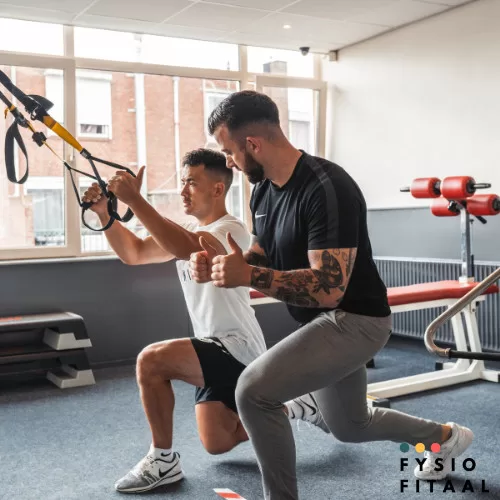Our 7 tips for working out with knee pain
Injuries are annoying! Some are more serious than others but generally speaking, it is not a reason to stop training altogether. You've often worked hard to be where you are today so don't let this injury get in your way. Here are 7 strategies to still keep training with knee problems.
Before we go any further, we want to point out that the tips we discuss here do NOT apply to traumatic knee injuries. Traumatic knee injuries are knee injuries that occur as a result of an accident.
Examples include:
- Contact injury in sports such as football, rugby, martial arts
- Rotational trauma, twisting your knee
- Displacement of the kneecap
- Hearing and/or feeling a distinct snap/crack during this accident
For complaints like this, always seek professional help before resuming training!
Complaints we discuss here fall more under the category of overuse complaints. These complaints often occur gradually and are more likely to be nagging than sharp pain.

1. You may feel pain but not suffer pain
Training through pain is never the way to go and it will get you nowhere in the long run. It's not worth doing that exercise anyway when you know in advance that it will make you suffer more. So make sure the symptoms you have remain acceptable. To make this more understandable, we often use a pain score. If you were to score pain on a scale of 0 to 10, you may score a maximum of a 3 for the complaints you are experiencing at that moment. When it is a 6,7,8 or higher, you know you are doing wrong! This also applies to the knee's reaction AFTER training. If you get up the next day and have more symptoms than the day before then you know you need to adjust something in your training. Sets, reps, weight, exercise choice are all variables you can adjust.
2. If you want to train the legs do more exercises that are hip dominant than knee dominant
Movements we describe as hip dominant are a; deadlift, glute bridge and, for example, a step up. These exercises are often a lot gentler on the knee than knee-dominant exercises like a squat or lunge. A tip from us is that when training legs with knee pain, do the hip-dominant exercises first. Then, if you do choose a squat and it doesn't score too high on pain, your legs are already a lot more tired. This makes that less weight is needed in the latter exercises to still get a decent stimulus. But still keep that pain score in the back of your mind, this doesn't change!
3. Train at a different angle
This advice is very similar to the previous one. But still a little different. Let's preface by saying that there is nothing wrong with knees past your toes when doing a squat. Just walk up the stairs without going knee past foot. Good luck! However, if you suffer from knee pain, it is kinder to move more hip dominant during a squat. A good example of this is a box squat. In this exercise, the knees stay behind the toes more than with a normal (back) squat. Don't worry about your quadriceps not getting enough attention. The factor for success in strength training and muscle building is consistency. Not squatting for a few weeks will do nothing to your current muscle mass. It takes much less to maintain muscle mass than to gain muscle mass. So always think about what works best in the long run. The goal should always be; which way can I keep this up the longest with the most results.
Below is a box squat. In this variation of the squat, the shin remains more vertical. This way, there is less pressure on the front of the knee. So still a squat variant but a bit more gentle.
4. Use resistance bands
If you find it difficult to focus more on the hip during a squat, it can help to use resistance bands. This will force you to lean more on the heel of your foot and lean backwards. This way, the peak load from the front of the knee is shifted to the back. The higher you get in the movement the more you still load your quadriceps. It is usually the case that when you have knee pain it is mainly during squats so when you are low in the movement. This way you still train quadriceps but in the more safe higher position. Here's an example:
5. A powersled is the perfect rehabilitation tool!
It cannot replace other strength exercises but training with a sledge is the perfect way to start. During an exercise like the squat, for example, you have a concentric moment (muscles shorten) and an eccentric moment (muscles lengthen) in the eccentric moment you brake the movement. During this braking, the muscles deliver power as they lengthen. This can be very taxing when you have complaints. With a sledge, you only have the concentric moment (muscles become shorter) which is gentler but you can still train considerable strength. Another advantage is that the recovery time for only concentric training is shorter than normal strength training. From concentric-only training you generally recover within 24 hours. With a sledge, you can train more often, which means your quadriceps are still sufficiently stimulated.
6. Cycling is always good
Cycling can almost always be done with knee pain. Personally, I would always do this as a warm-up when you have knee pain and start exercising. Movement is pain dampening. When certain fibres are stimulated, these signals enter the brain and extinguish the signal for pain more. It also causes stiff connective tissue to become a little more elastic, making you move just a little easier. Take your time and cycle for at least 15 minutes before exercising with light resistance.
7. Blood flow restriction training (BFR)/Kaatsu
With BFR or kaatsu training, you train with a light training load while ensuring a low-oxygen environment in the legs. This allows you to have the same effects at a low training intensity as if you were training at a high intensity (in this case weight). You do this by using a cuff. This is a kind of blood pressure gauge that you can pump up. This pinches off the leg and thus creates a localised oxygen-depleted area in the legs. A lot of metabolic stress is released by this type of training. For example, one of the substances released is lactate. Together with other substances, we know that lactate plays a role in building muscle mass. If you want to do this, however, we recommend going through it with a professional at least the first time. This way, you will know how best to use the cuffs and what you may approximately feel during this workout.
These were our 7 tips for working out with knee pain. Also, make sure you give your body some time to recover. We know that not training once for 2-3 weeks has no real adverse effects on strength or muscle mass. When in doubt just grab some rest, make a appointment and look at other muscle groups that might need a little more attention. We often see that despite this advice, training is still done too hard and the body is not really listened to!

